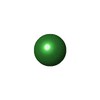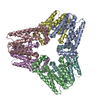+Search query
-Structure paper
| Title | Discovery of non-squalene triterpenes. |
|---|---|
| Journal, issue, pages | Nature, Vol. 606, Issue 7913, Page 414-419, Year 2022 |
| Publish date | Jun 1, 2022 |
 Authors Authors | Hui Tao / Lukas Lauterbach / Guangkai Bian / Rong Chen / Anwei Hou / Takahiro Mori / Shu Cheng / Ben Hu / Li Lu / Xin Mu / Min Li / Naruhiko Adachi / Masato Kawasaki / Toshio Moriya / Toshiya Senda / Xinghuan Wang / Zixin Deng / Ikuro Abe / Jeroen S Dickschat / Tiangang Liu /    |
| PubMed Abstract | All known triterpenes are generated by triterpene synthases (TrTSs) from squalene or oxidosqualene. This approach is fundamentally different from the biosynthesis of short-chain (C-C) terpenes that ...All known triterpenes are generated by triterpene synthases (TrTSs) from squalene or oxidosqualene. This approach is fundamentally different from the biosynthesis of short-chain (C-C) terpenes that are formed from polyisoprenyl diphosphates. In this study, two fungal chimeric class I TrTSs, Talaromyces verruculosus talaropentaene synthase (TvTS) and Macrophomina phaseolina macrophomene synthase (MpMS), were characterized. Both enzymes use dimethylallyl diphosphate and isopentenyl diphosphate or hexaprenyl diphosphate as substrates, representing the first examples, to our knowledge, of non-squalene-dependent triterpene biosynthesis. The cyclization mechanisms of TvTS and MpMS and the absolute configurations of their products were investigated in isotopic labelling experiments. Structural analyses of the terpene cyclase domain of TvTS and full-length MpMS provide detailed insights into their catalytic mechanisms. An AlphaFold2-based screening platform was developed to mine a third TrTS, Colletotrichum gloeosporioides colleterpenol synthase (CgCS). Our findings identify a new enzymatic mechanism for the biosynthesis of triterpenes and enhance understanding of terpene biosynthesis in nature. |
 External links External links |  Nature / Nature /  PubMed:35650436 / PubMed:35650436 /  PubMed Central PubMed Central |
| Methods | EM (single particle) / X-ray diffraction |
| Resolution | 2 - 4.0 Å |
| Structure data | EMDB-32531: Cryo-EM structure of prenyltransferase domain of Macrophoma phaseolina macrophomene synthase at 3.17 angstrom resolution  EMDB-32532: Cryo-EM structure of cross-linked Macrophomina phaseolina macrophomene synthase at 4.0 angstrom resolution  PDB-7vta:  PDB-7vtb: |
| Chemicals |  ChemComp-HOH:  ChemComp-NI: |
| Source |
|
 Keywords Keywords |  TRANSFERASE / Talaromyces verruculosus / talaropentaene synthase / triterpene / Macrophoma phaseolina / Macrophomene Synthase / TRANSFERASE / Talaromyces verruculosus / talaropentaene synthase / triterpene / Macrophoma phaseolina / Macrophomene Synthase /  prenyltransferase prenyltransferase |
 Movie
Movie Controller
Controller Structure viewers
Structure viewers About Yorodumi Papers
About Yorodumi Papers






